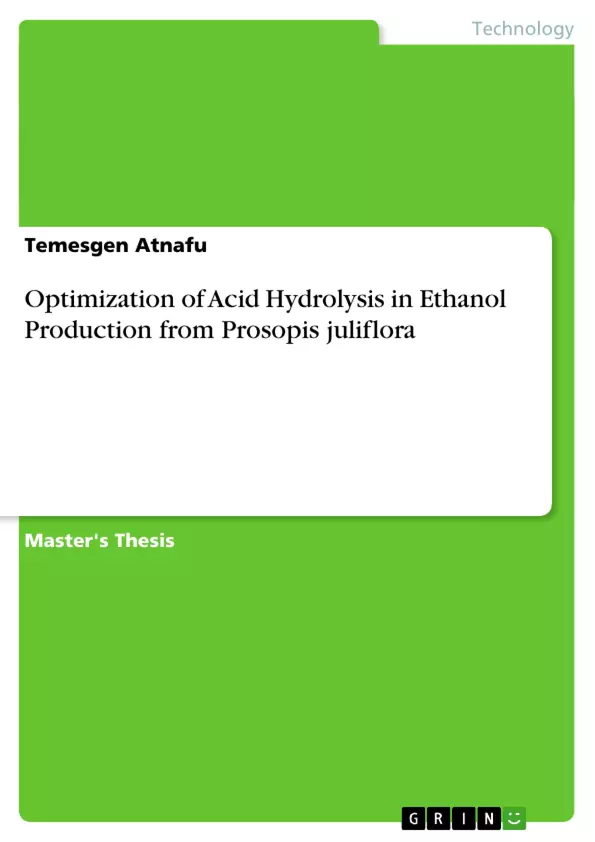Lignocellulosic materials (eg.Prosopis juliflora) can be utilized to produce ethanol, a promising alternative energy source for the limited crude oil. This study involved optimisation of acid hydrolysis in ethanol production from prosopis juliflora. The conversion of prosopis juliflora to ethanol can be achieved mainly by three process steps: pretreatment of prosopis juliflora wood to remove lignin and hemicellulose, acid hydrolysis of pretreated prosopis juliflora to convert cellulose into reducing sugar(glucose) and fermentation of the sugars to ethanol using Saccharomyces cerevisiae in anaerobic condition. A two level full factorial design with four factors, two levels and two replicas (24*2=32 experimental runs) was applied to optimize acid hydrolysis and study the interaction effects of acid hydrolysis factors, namely, acid concentration, solid fraction, temperature, and time. An optimization was carried out to optimize acid hydrolysis process variables so as to determine the best acid concentration, solid fraction, temperature, and contact time that resulted maximum ethanol yield. The screening of significant acid hydrolysis factors were done by using the two-level full factorial design using design expert® 7 software. The statistical analysis showed that the ethanol yield of (40.91% (g/g)) was obtained at optimised acid hydrolysis variables of 0.5%v/v acid concentration, 5%w/w solid fraction,105.01°C temperature, and 10 minutes hydrolysis time.
Keywords: Prosopis juliflora, pretreatment, hydrolysis, fermentation, 2 level factorial, optimization.
Inhaltsverzeichnis (Table of Contents)
- Acknowledgement
- List of Tables
- List of Figures
- List of Acronyms
- Abstract
- 1. Introduction
- 1.1 Background
- 1.2 Statement of the Problem
- 1.3 Objectives
- 1.3.1 General Objectives
- 1.3.2 Specific objective
- 1.4 Significance of the Research
- 2. Literature Review
- 2.1 Introduction
- 2.1.1 Biofuel Types
- 2.1.2 Ethanol as fuel
- 2.1.3 World market of ethanol
- 2.1.4. Ethanol production and supply in Ethiopia
- 2.2 Ethanol Feedstocks
- 2.2.1. Starch Feedstocks
- 2.2.2 Sugar Feedstocks
- 2.2.3 Lignocellulosic Feedstocks
- 2.3 Lignocellulosic Biomass as Ethanol Feedstock
- 2.3.1 Lignocellulosic Biomass
- 2.3.2 Composition of Lignocellulosic Materials
- 2.3.3 Prosopis juliflora as Ethanol feedstock
- 2.3.4 Prosopis juliflora in Ethiopia
- 2.4 Production Methods of Cellulosic Ethanol
- 2.4.1 Biochemical Conversion (sugar platform)
- 2.4.2Thermochemical Conversion (Syngas Platform)
- 2.1 Introduction
- 3. Materials and Methods
- 3.1 Time and Place of the Study
- 3.2 Materials
- 3.3 Methods
- 3.3.1 Prosopis juliflora Sample collection area
- 3.3.2 Sample collection
- 3.3.3 Sample Preparation
- 3.3.4 Pretreatment of Prosopis Juliflora
- 3.3.5 Hydrolysis
- 3.3.6 pH adjustment
- 3.3.7 Fermentation
- 3.3.8. Distillation
- 3.4 Data Analysis
- 4. Results and Discussion
- 4.1 Statistical Analysis of the Experimental Results
- 4.2 Interaction effects
- 4.3 Optimization
- 4.4 Model validation
- 5. Conclusion and Recommendation
- 5.1 Conclusion
- 5.2 Recommendations
- References
Zielsetzung und Themenschwerpunkte (Objectives and Key Themes)
The study aims to optimize the acid hydrolysis process for producing ethanol from Prosopis juliflora biomass. The research focuses on identifying the optimal conditions for maximizing ethanol yield and exploring the impact of various process parameters on the efficiency of the hydrolysis step. The thesis delves into the following key themes:- Ethanol production from lignocellulosic biomass, specifically Prosopis juliflora.
- Optimization of acid hydrolysis process parameters for maximizing ethanol yield.
- Evaluation of the impact of different process variables on hydrolysis efficiency.
- Analysis of the chemical and physical properties of Prosopis juliflora biomass.
- Exploration of the potential of Prosopis juliflora as a sustainable and cost-effective feedstock for ethanol production.
Zusammenfassung der Kapitel (Chapter Summaries)
- Chapter 1: Introduction This chapter provides an overview of the research background, problem statement, objectives, and the significance of the study. It discusses the importance of ethanol as a biofuel and highlights the potential of Prosopis juliflora as a sustainable feedstock for ethanol production in Ethiopia.
- Chapter 2: Literature Review This chapter examines the existing literature on ethanol production from lignocellulosic biomass, focusing on Prosopis juliflora. It reviews different biofuel types, ethanol production methods, and the composition of lignocellulosic materials. The chapter also discusses the potential of Prosopis juliflora as a feedstock in Ethiopia.
- Chapter 3: Materials and Methods This chapter outlines the materials and methods used in the study. It details the sample collection process, preparation methods, pretreatment techniques, and hydrolysis procedure. The chapter also discusses the fermentation and distillation steps involved in ethanol production and the statistical analysis methods employed.
- Chapter 4: Results and Discussion This chapter presents the experimental results and analyzes the data obtained. It investigates the effects of various process parameters on hydrolysis efficiency, including the influence of acid concentration, temperature, and reaction time. The chapter also explores the interaction effects of these parameters and discusses the optimization of the acid hydrolysis process for maximizing ethanol yield.
Schlüsselwörter (Keywords)
The key concepts and topics covered in this study include: ethanol production, Prosopis juliflora, lignocellulosic biomass, acid hydrolysis, process optimization, ethanol yield, sustainable biofuel, and feedstock analysis. The research focuses on understanding the potential of Prosopis juliflora as a sustainable source for ethanol production in Ethiopia.- Quote paper
- Temesgen Atnafu (Author), 2012, Optimization of Acid Hydrolysis in Ethanol Production from Prosopis juliflora, Munich, GRIN Verlag, https://www.grin.com/document/206117



